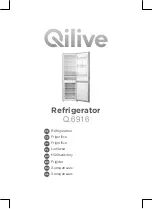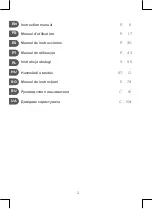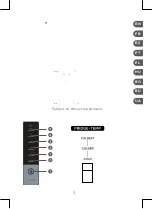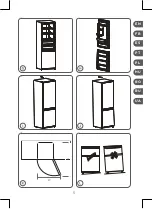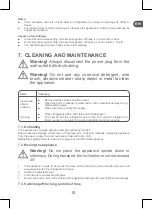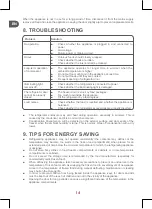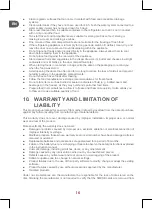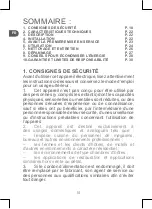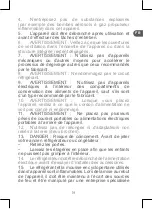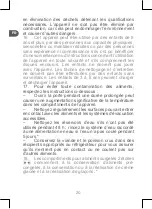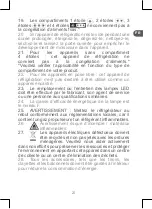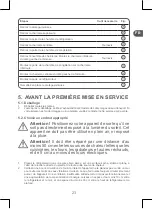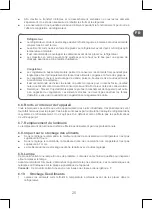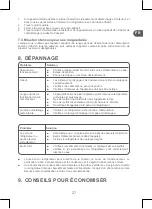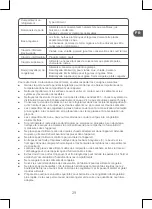
14
14
FR
EN
When the appliance is not in use for a long period of time, disconnect it from the mains supply,
remove all food and clean the appliance. Leaving the door slightly ajar to prevent unpleasant smells.
8. TROUBLESHOOTING
Problem
Solution
No operation.
■
Check whether the appliance is plugged in and connected to
power.
■
Low voltage.
■
Failure power or tripping circuit.
Odour.
■
Odorous foods should closely wrapped.
■
Check whether foods are rotten.
■
Check whether the interior shall be cleaned.
Long-term operation
of compressor.
■
The appliance operates for longer time in summer when the
ambient temperature is higher.
■
Do not put too much food in the appliance at one time.
■
Do not put foods until they are cooled.
■
Frequent opening of refrigerator door.
Illuminating light
remains off.
■
Check whether the refrigerator is connected to power.
■
Check whether the illuminating light is damaged.
The refrigerator door
cannot be properly
closed.
■
The freezer door is stuck by food packages.
■
Too much food inside the appliance.
■
Tilt the refrigerator by a few degrees.
Loud noises.
■
Check whether the food is levelled and whether the appliance is
balanced.
■
Check whether the refrigerator accessories are properly inserted.
■
The refrigerator enclosure may emit heat during operation, especially in summer. This is
caused by the condenser, and it is a normal phenomenon.
■
Condensation phenomenon will be detected on the exterior surface and door seals of the
freezer when the ambient humidity is large. This is normal. Wipe off condensation with a dry
towel.
9. TIPS FOR ENERGY SAVING
■
Refrigerating appliances may not operate consistently (the contents may defrost or the
temperature may become too warm in the frozen food compartment) when placed for an
extended period of time below the minimum temperature for which the refrigerating appliance
is designed.
■
Do not store fizzy drinks in food freezer compartments or cabinets or in low-temperature
compartments or cabinets.
■
Do not exceed the storage time recommended by the food manufacturer (especially for
commercially quick-frozen food).
■
When defrosting the appliance, take necessary precautions to prevent an undue rise in the
temperature of frozen food, such as wrapping the frozen food in several layers of newspaper.
A rise in the temperature of frozen food during manual defrosting, maintenance or cleaning
may shorten the storage life.
■
In order to prevent children from being locked inside the appliance, keys for doors and lids
must be kept out of the reach of children and not in the vicinity of the appliance.
■
Opening the door for long periods can cause a significant increase of the temperature in the
appliance compartments.
Summary of Contents for Q.6916
Page 3: ...3 EN FR ES PT PL HU RO UA RU Subject to the actual product...
Page 4: ...4 FR EN ES IT PT PL HU RU RO ES FR PT PL HU RO UA RU...
Page 5: ...5 EN FR ES PT PL HU RO UA RU W H...
Page 92: ...92 RO RU 1 1 2 3 1 C 92 2 C 96 3 C 96 4 C 96 5 C 97 6 C 98 7 C 100 8 C 101 9 C 101 10 C 103...
Page 93: ...93 RU 4 5 6 7 8 9 10 11 12 13 14 15...
Page 94: ...94 RO RU 16 8 3 8 17 48 5 18...
Page 95: ...95 RU 19 20 21 4 22 23 24 F 25 26 27 28...
Page 97: ...97 RU 5 5 1 1 2 5 2 50 5 1...
Page 99: ...99 RU 6 4 6 5 6 6 6 7 6 8 3 1...
Page 100: ...100 RO RU 6 9 F 6 10 1 2 3 2 3 1 7...
Page 101: ...101 RU 7 1 7 2 45 1 2 3 4 7 3 8...
Page 102: ...102 RO RU 9 48 5 3 5...
Page 103: ...103 RU 48 5 3 4...
Page 104: ...104 RO RU 10 3 6 SIM SD IMEI 3...
Page 106: ...106 RU UA 4 5 6 7 8 9 10 11 12 13 14 15...
Page 107: ...107 UA 16 8 3 8 17 48 5 18 19...
Page 108: ...108 RU UA 20 21 4 22 23 24 F 25 26 27 28...
Page 110: ...110 RU UA 5 5 1 1 2 5 2 50 5 1...
Page 112: ...112 RU UA 6 4 6 5 6 6 6 7 6 8 3 1...
Page 113: ...113 UA 6 9 F 6 10 1 2 3 2 3 1 7...
Page 114: ...114 RU UA 7 1 7 2 45 1 2 3 4 7 3 8...
Page 115: ...115 UA 9 48 5 3 5...
Page 116: ...116 RU UA 48 5 3 4...
Page 117: ...117 UA 10 3 6 SIM SD IMEI 3...
Page 118: ......
Page 119: ......

